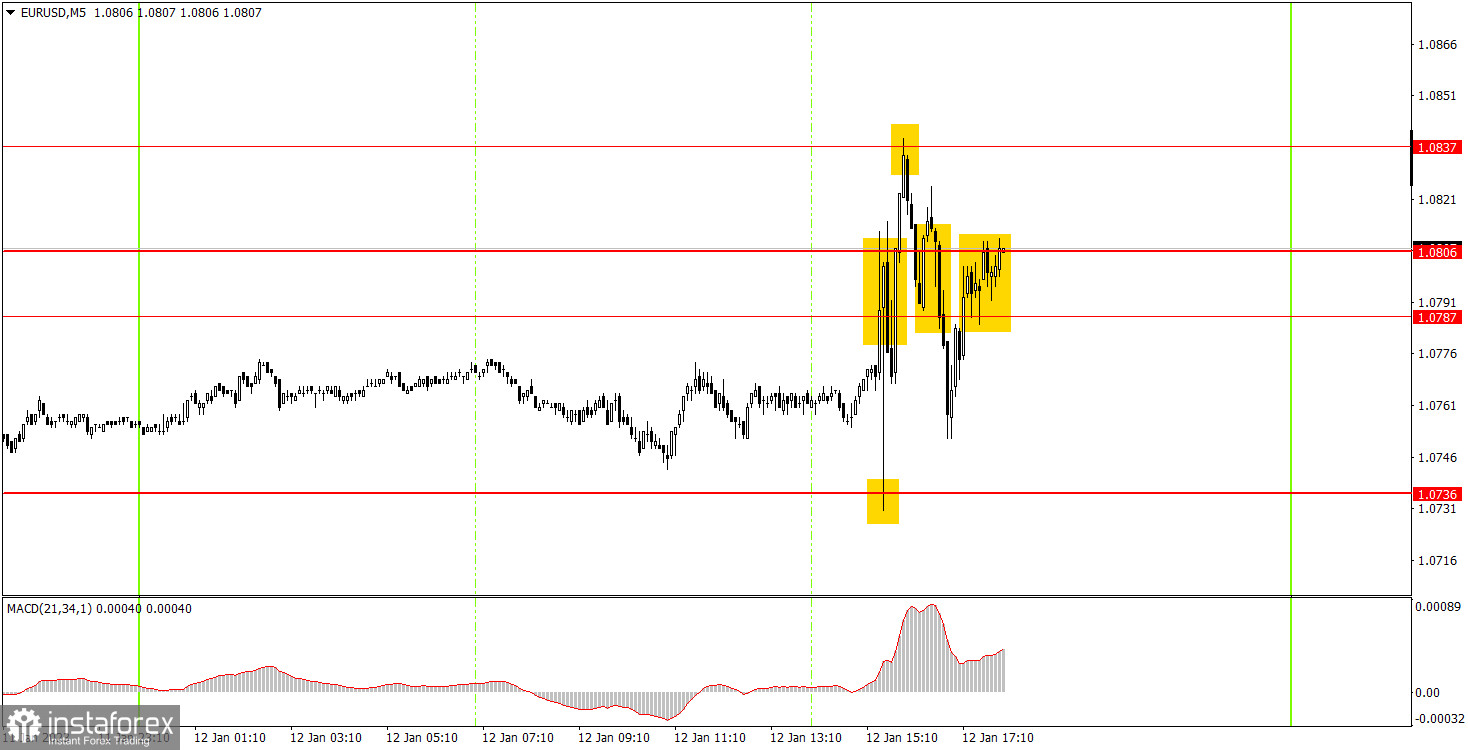Analyzing Thursday's trades:
EUR/USD on 30M chart

EUR/USD continued to trade rather impassively, but that all changed when the US published its inflation report. I warned you that there could be a surge of emotions on the market, so no one should be surprised by the fact that volatility increased in the US trading session. Unfortunately, today's trading does not clarify the technical picture at all, since it is still difficult to form a channel or trend line on the 30-minute chart. The uptrend seems to be there, but it is impossible to outline it and set its reference points. US inflation dropped to 6.5%, which caused the dollar to fall quite rightly. And everything would be fine and logical, if the dollar did not immediately recoup all the losses. That's why by the end of the day, the euro went up again, but we're not confident that it will keep going up. In general, the situation is still quite confusing, although we seem to have a clear uptrend. There are still many questions about the euro's current growth.
EUR/USD on M5 chart

All of the trading signals were produced in the US trading session, when strong movements, provoked by the US inflation report, began. Basically, novice traders didn't have many chances to open positions since the price was just "flying" from side to side. Moreover, I advise you not to open any position since it's a very important report. Despite the fact that 1.0736 and 1.0837 were perfectly balanced, it was dangerous to open positions. Thus, I believe that beginners should not enter the market today. If there is a position to be opened, it should be done only on a sell signal near 1.0837, when some time has already passed after the release of the inflation report. It was possible to earn a few dozens of pips on this trade.
Trading tips on Friday:
The pair started a new upward movement on the 30-minute chart. There were quite specific reasons for the pair's growth, but in general, there are few of them and the market is not willing to enter a bearish correction. I still believe that the euro should fall significantly, but the market shows that it is not ready to sell and uses any excuse to buy the euro. In between they enjoy a flat. On the 5-minute chart, it is recommended to trade at the levels 1.0657-1.0668, 1.0697, 1.0736, 1.0787-1.0806, 1.0837, 1.0905, 1.0923-1.0933, 1.0966 and 1.0989. As soon as the price passes 15 pips in the right direction, you should set a Stop Loss to breakeven. On Friday, only the EU industrial production report and the US consumer sentiment index from the University of Michigan will be released. Not the most important data, but the euro can rise without it.
Basic rules of the trading system:
1) The strength of the signal is determined by the time it took the signal to form (a rebound or a breakout of the level). The quicker it is formed, the stronger the signal is.
2) If two or more positions were opened near a certain level based on a false signal (which did not trigger a Take Profit or test the nearest target level), then all subsequent signals at this level should be ignored.
3) When trading flat, a pair can form multiple false signals or not form them at all. In any case, it is better to stop trading at the first sign of a flat movement.
4) Trades should be opened in the period between the start of the European session and the middle of the US trading hours when all positions must be closed manually.
5) You can trade using signals from the MACD indicator on the 30-minute time frame only amid strong volatility and a clear trend that should be confirmed by a trendline or a trend channel.
6) If two levels are located too close to each other (from 5 to 15 pips), they should be considered support and resistance levels.
On the chart:
Support and Resistance levels are the levels that serve as targets when buying or selling the pair. You can place Take Profit near these levels.
Red lines are channels or trend lines that display the current trend and show in which direction it is better to trade now.
The MACD indicator (14, 22, and 3) consists of a histogram and a signal line. When they cross, this is a signal to enter the market. It is recommended to use this indicator in combination with trend patterns (channels and trendlines).
Important announcements and economic reports that can be found on the economic calendar can seriously influence the trajectory of a currency pair. Therefore, at the time of their release, we recommend trading as carefully as possible or exiting the market in order to avoid sharp price fluctuations.
Beginners on Forex should remember that not every single trade has to be profitable. The development of a clear strategy and money management is the key to success in trading over a long period of time.
 English
English 
 Русский
Русский Bahasa Indonesia
Bahasa Indonesia Bahasa Malay
Bahasa Malay ไทย
ไทย Español
Español Deutsch
Deutsch Български
Български Français
Français Tiếng Việt
Tiếng Việt 中文
中文 বাংলা
বাংলা हिन्दी
हिन्दी Čeština
Čeština Українська
Українська Română
Română

